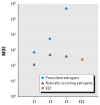An assessment of potential exposure and risk from estrogens in drinking water
- PMID: 20194073
- PMCID: PMC2854760
- DOI: 10.1289/ehp.0900654
An assessment of potential exposure and risk from estrogens in drinking water
Erratum in
- Environ Health Perspect. 2010 Mar;118(3):343
Abstract
Background: Detection of estrogens in the environment has raised concerns in recent years because of their potential to affect both wildlife and humans.
Objectives: We compared exposures to prescribed and naturally occurring estrogens in drinking water to exposures to naturally occurring background levels of estrogens in the diet of children and adults and to four independently derived acceptable daily intakes (ADIs) to determine whether drinking water intakes are larger or smaller than dietary intake or ADIs.
Methods: We used the Pharmaceutical Assessment and Transport Evaluation (PhATE) model to predict concentrations of estrogens potentially present in drinking water. Predicted drinking water concentrations were combined with default water intake rates to estimate drinking water exposures. Predicted drinking water intakes were compared to dietary intakes and also to ADIs. We present comparisons for individual estrogens as well as combined estrogens.
Results: In the analysis we estimated that a child's exposures to individual prescribed estrogens in drinking water are 730-480,000 times lower (depending upon estrogen type) than exposure to background levels of naturally occurring estrogens in milk. A child's exposure to total estrogens in drinking water (prescribed and naturally occurring) is about 150 times lower than exposure from milk. Adult margins of exposure (MOEs) based on total dietary exposure are about 2 times smaller than those for children. Margins of safety (MOSs) for an adult's exposure to total prescribed estrogens in drinking water vary from about 135 to > 17,000, depending on ADI. MOSs for exposure to total estrogens in drinking water are about 2 times lower than MOSs for prescribed estrogens. Depending on the ADI that is used, MOSs for young children range from 28 to 5,120 for total estrogens (including both prescribed and naturally occurring sources) in drinking water.
Conclusions: The consistently large MOEs and MOSs strongly suggest that prescribed and total estrogens that may potentially be present in drinking water in the United States are not causing adverse effects in U.S. residents, including sensitive subpopulations.
Figures



Similar articles
-
Human pharmaceuticals in US surface waters: a human health risk assessment.Regul Toxicol Pharmacol. 2005 Aug;42(3):296-312. doi: 10.1016/j.yrtph.2005.05.005. Regul Toxicol Pharmacol. 2005. PMID: 15979221
-
A preliminary risk assessment of potential exposure to naturally occurring estrogens from Beijing (China) market milk products.Food Chem Toxicol. 2014 Sep;71:74-80. doi: 10.1016/j.fct.2014.05.028. Epub 2014 Jun 6. Food Chem Toxicol. 2014. PMID: 24910459
-
Dietary exposure of children in lead-laden environments.J Expo Anal Environ Epidemiol. 2000 Nov-Dec;10(6 Pt 2):723-31. doi: 10.1038/sj.jea.7500131. J Expo Anal Environ Epidemiol. 2000. PMID: 11138664
-
Total allowable concentrations of monomeric inorganic aluminum and hydrated aluminum silicates in drinking water.Crit Rev Toxicol. 2012 May;42(5):358-442. doi: 10.3109/10408444.2012.674101. Crit Rev Toxicol. 2012. PMID: 22512666 Review.
-
Dietary exposure to copper in the European Union and its assessment for EU regulatory risk assessment.Sci Total Environ. 2007 Mar 15;374(2-3):223-34. doi: 10.1016/j.scitotenv.2006.12.041. Epub 2007 Jan 31. Sci Total Environ. 2007. PMID: 17270248 Review.
Cited by
-
Endocrine Disruptors in Water and Their Effects on the Reproductive System.Int J Mol Sci. 2020 Mar 12;21(6):1929. doi: 10.3390/ijms21061929. Int J Mol Sci. 2020. PMID: 32178293 Free PMC article. Review.
-
Endocrine disruption through membrane estrogen receptors and novel pathways leading to rapid toxicological and epigenetic effects.J Steroid Biochem Mol Biol. 2019 Mar;187:106-117. doi: 10.1016/j.jsbmb.2018.11.007. Epub 2018 Nov 19. J Steroid Biochem Mol Biol. 2019. PMID: 30465854 Free PMC article. Review.
-
Indicator Compounds Representative of Contaminants of Emerging Concern (CECs) Found in the Water Cycle in the United States.Int J Environ Res Public Health. 2021 Feb 1;18(3):1288. doi: 10.3390/ijerph18031288. Int J Environ Res Public Health. 2021. PMID: 33535451 Free PMC article. Review.
-
Human Health Relevance of Pharmaceutically Active Compounds in Drinking Water.AAPS J. 2015 May;17(3):558-85. doi: 10.1208/s12248-015-9729-5. Epub 2015 Mar 5. AAPS J. 2015. PMID: 25739816 Free PMC article.
-
Unused and Expired Medications Disposal Practices among the General Public in Selangor, Malaysia.Pharmacy (Basel). 2020 Oct 23;8(4):196. doi: 10.3390/pharmacy8040196. Pharmacy (Basel). 2020. PMID: 33114172 Free PMC article.
References
-
- Aerni HR, Kobler B, Rutishauser BV, Wettstein FE, Fischer R, Giger W, et al. Combined biological and chemical assessment of estrogenic activities in wastewater treatment plant effluents. Anal Bioanal Chem. 2004;378:688–696. - PubMed
-
- Aherne GW, Briggs R. The relevance of the presence of certain synthetic steroids in the aquatic environment. J Pharm Pharmacol. 1989;41(10):735–736. - PubMed
-
- Aksglaede L, Juul A, Leffers H, Skakkebaek NE, Andersson AM. The sensitivity of the child to sex steroids: possible impact of exogenous estrogens. Hum Reprod Update. 2006;12(4):341–349. - PubMed
-
- Anderson PD, D’Aco VJ, Shanahan P, Chapra SC, Hayes P, Buzby ME, et al. Screening analysis of human pharmaceuticals in U.S. surface waters. Environ Sci Technol. 2004;38(3):838–849. - PubMed
-
- Andersson AM, Skakkebaek NE. Exposure to exogeneous estrogens in food: possible impact on human development and health. Eur J Endocrinol. 1999;140:477–485. - PubMed
Publication types
MeSH terms
Substances
LinkOut - more resources
Full Text Sources
Medical

